A mutation is any heritable change in the genetic material. In other words, a mutation is an alteration in the nucleotide sequence of the DNA or, in the case of RNA viruses, an alteration in the nucleotide sequence of its genomic RNA. Mutations can happen at any time and in any cell. Also, it can arise from a variety of sources. For example, point mutations can occur spontaneously during replication of the DNA through the misincorporation of a nucleotide and the failure of the editing mechanisms to correct the mistake or through the chemical instability of the nucleotides. There are various types of mutation and I will discuss that later in this article.
Mutation Definition
A Mutation refers to any sudden, heritable change in the genotype of a cell or an organism. Mutational changes in the genotype of an organism. It includes changes in chromosome number and structure, as well as changes in the structures of individual genes.
Significance of Mutation
The mutation is the ultimate source of all genetic variation as it provides the raw material for evolution. Without mutation, all genes would exist in only one form. Alleles would not exist, and classical genetic analysis would not be possible. Most important, populations of organisms would not be able to evolve and adapt to environmental changes.
Moreover, mutations are both the sustainer of life and the cause of great suffering. On the one hand, mutation is the source of all genetic variation, the raw material of evolution. On the other hand, many mutations have detrimental effects, and mutation is the source of many human diseases and disorders.
Some level of mutation is essential to provide new genetic variability. It also allows organisms to adapt to new environments. At the same time, if mutations occurred too frequently, they would disrupt the transfer of genetic information from one generation to another.
Types of Mutations
Mutations can be classified in a variety of ways. We can distinguish between two broad categories of mutations by cell type: somatic mutations, and germline mutations.
Mutations can also be classified by other criteria, such as the kinds of alterations in the DNA, the kinds of phenotypic effects produced, and whether the mutational events are spontaneous in origin or were induced by exposure to a known mutagen.
1. Classification based on type of cells
Depending on the type of cell, mutation can be of following types:
- a. somatic mutation
- b. germ-line mutation
1.a. Somatic mutation
The somatic mutation occurs in non-reproductive cells (somatic cells). When a mutant somatic cell divides (mitosis), the mutation will pass on to the daughter cells, resulting in a population of genetically identical cells.
Because of the huge number of cells present in a typical eukaryotic organism, somatic mutations are numerous. For example, there are about 1014 cells in the human body. Typically, a mutation arises once in every million cell divisions, and so hundreds of millions of somatic mutations must arise in each person. However, cells with a somatic mutation that stimulates cell division can increase in number and spread; this type of mutation is the basis for all cancers.
1.b. Germ-line mutation
The germ-line mutation occurs in cells that give rise to gametes. A germ-line mutation can be passed to future generations, producing individual organisms that carry the mutation in all their somatic and germ-line cells.
2.Molecular basis of mutation
On the basis of the molecular nature of defects, there are three types of mutation:
- a. base substitution
- 1. transition
- 2. transversion
- b. insertion and deletions
- 1. frameshift mutation
- c. expanding nucleotide repeats
2.a. Base substitution (point mutation)
It is the simplest type of gene mutation in which an alteration of a single nucleotide in the DNA occurs. Further, base substitution is of two types. One is transition while the other is transversion.
2.a.1 Transition mutation
In a transition, a purine is replaced by a different purine or, alternatively, a pyrimidine is replaced by a different pyrimidine. The possible transition mutations are:
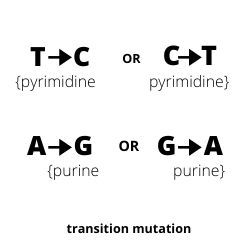
Transversion mutation
Unlike transition, in a transversion, a pyrimidine replaces a purine, or a purine replaces a pyrimidine. Although the number of possible transversions is twice the number of possible transitions, transitions arise more frequently. The possible transversion mutations are:
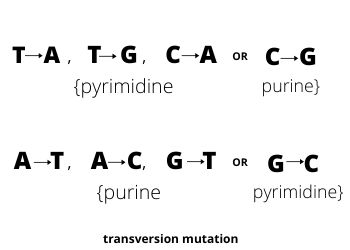
Altogether, there are four possible transitions and eight possible transversions. Spontaneous base substitutions are biased in favor of transitions. Among spontaneous base substitutions, the ratio of transitions to transversions is approximately 2: 1.
2.b. Insertion and deletions
The second major class of gene mutations contains insertions and deletions. It basically refers to the addition or deletion of one or more nucleotide pair at a point. Small deletions may remove one or a few base pairs within a gene, while larger deletions can remove an entire gene or several neighbouring genes. As a result, the protein made by the gene may not function properly.
2.b.1. Frameshift mutation
Frameshift mutations, by additions or deletions of nucleotides, cause an alteration in the reading frame of codons. It usually alters all amino acids encoded by nucleotides following the mutation, and so they generally have drastic effects on the phenotype. Basically, point mutations that add or subtract a base are, potentially, the most devastating in their effects on the cell or organism because they change the reading frame of a gene from the site of mutation onward.
Typically, a frameshift mutation causes two problems. First, all the codons from the frameshift on will be different and thus yield (most probably) a useless protein. Secondly, stop-signal information will be misread.
2.c. Expanding trinucleotide repeats
In expanding trinucleotide repeats, the number of copies of trinucleotide increases in number. This type of mutation was first observed in a gene FMR-1, which causes the fragile-X syndrome, the most common hereditary cause of mental retardation.
Expanding trinucleotide repeats have been found in other human genetic diseases also. For example, Spinal and bulbar muscular atrophy, Jacobsen syndrome, Myotonic dystrophy, etc.
3. Types of Mutations depending on phenotypic effects
Mutations have a variety of phenotypic effects. The phenotypic effect of a mutation is realized when the mutant is compared with the wild-type phenotype. Here, I am sharing you a list of all types of mutation that occurs due to phenotypic effects.
- a. forward
- b. reverse
- c. missense
- 1. neutral
- d. nonsense
- e. silent
- f. loss of function
- g. gain of function
- h. conditional
- i. lethal
3.a Forward mutation
A mutation that alters the wild-type allele into a mutant allele is called a forward mutation.
3.b. Reverse Mutation
As the name suggests, it is reverse of the forward mutation. In reverse mutation, a mutant allele changes back to the wild-type allele.
3.c. Missense (point mutation)
A base substitution that results in a different amino acid in the protein is referred to as a missense mutation. Further, missense mutations can render the resulting protein nonfunctional. Such mutations are responsible for human diseases. For example, sickle-cell disease.
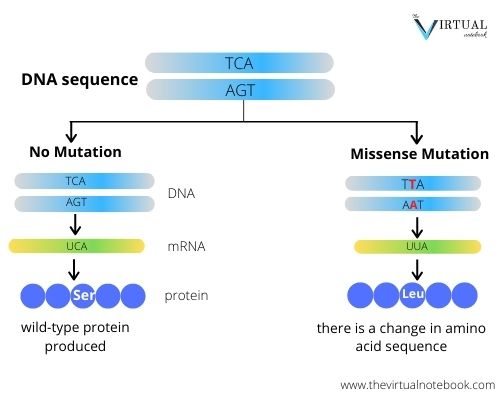
3.c.1. Neutral
A neutral mutation is a missense mutation that alters the amino acid sequence of the protein but does not change its function. It occurs when one amino acid replaces another chemically similar amino acid.
3.d. Nonsense (a type of point mutation)
A nonsense mutation changes a sense codon (one that specifies an amino acid) into a nonsense codon (one that terminates translation). In other words, it prematurely stops the translation of mRNA and results in an incomplete or usually nonfunctional protein product.
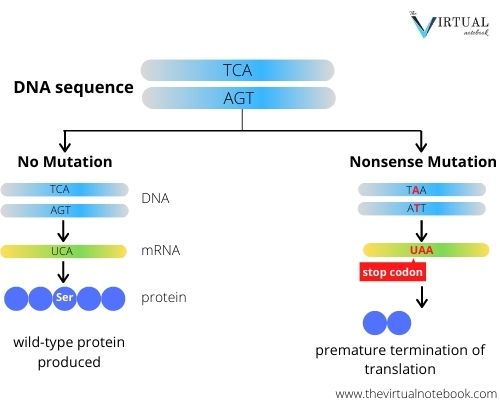
3.e. Silent (point mutation)
A silent mutation creates a different DNA sequence that specifies the same amino acid as the wild-type sequence does.
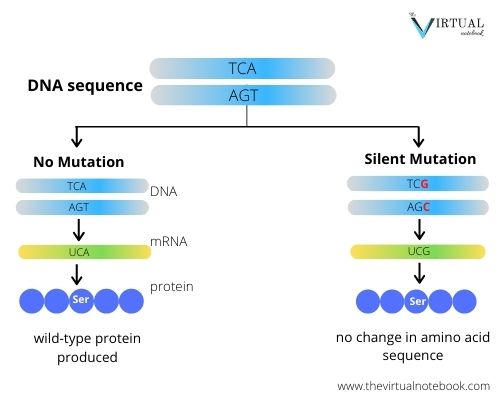
3.f. Loss of function
Particularly, a loss of function mutation causes partial or complete absence of normal protein function. Phenotypes associated with such mutations are most often recessive. Loss of function mutation is dominant only in haploid organism.
3.g Gain of function
In contrast, a gain-of-function mutation produces an entirely new trait or it causes a trait to appear in an inappropriate tissue or at an inappropriate time in development. Further, gain-of-function mutations are frequently dominant in their expression.
3.h. Conditional
This type of mutations is expressed only under certain conditions or environmental factor. Sometimes, these mutations result in defective functions that make the survival of the organism difficult under specific conditions. For example, temperature-dependent or temperature-sensitive mutation. These mutations cause the organism to be at risk of cell death when the temperature rises above or diminishes below a certain level. In such cases, the restrictive temperature condition leads to severe dysfunction.
3.i. Lethal
The lethal mutation causes premature death of the organism. Dominant lethal kill heterozygotes whereas recessive lethal kill homozygotes only.
4. Suppressor mutation
A suppressor mutation is a genetic change that hides or suppresses the effect of another mutation. A suppressor mutation occurs at a site that is distinct from the site of the original mutation. Thus, an individual with a suppressor mutation is a double mutant, possessing both the original mutation and the suppressor mutation.
Please note that suppression mutation is different from reverse mutation. Wonder How? Well… let me tell you that in reverse mutation, the mutated gene will revert back to the wild-type sequence whereas suppression masks the occurrence of the original mutation without actually restoring the original sequence.
5. Spontaneous and Induced mutation
Mutations result from both internal and external factors. Those that are a result of natural changes in DNA structure are termed spontaneous mutations, whereas those that result from changes caused by environmental chemicals or radiation are induced mutations.
Mutation Rate
The mutation rate is the number of mutations that arise per cell division in bacteria and single-celled organisms or the number of mutations that arise per gamete in higher organisms. Most genes are relatively stable and a mutation is a rare event. However, mutation rates vary tremendously depending upon the length of genetic material, the kind of mutation, and other factors. For example, the mutation rate per cell division in E. coli is 3 x 10-8 whereas the lethal mutation rate in Drosophila is about 1 x 10-2 per gamete for the total genome.
Mutations occur much more frequently in certain regions of the gene than in others. The favoured regions are called hot spots.
SOURCES AND EXTERNAL LINKS
Genetics Essentials: concepts and connections by Benjamin A. Pierce, chapter 13: Gene Mutations, Transposable Elements, and DNA Repair.
Principles of Genetics by Robert H. Tamarin, 7th edition; chapter 12: DNA: Its Mutation, Repair, and Recombination.
Genetics and Molecular Biology by Robert Schleif, second edition ; chapter 8 genetics
Also, Genetics: A Conceptual Approach by Benjamin A. Pierce , fourth edition chapter 18: Gene Mutations and DNA repair
Lastly, Genetics Principles and analysis Fourth Edition, Daniel L. and Hartl Elizabeth W. Jones, Chapter 13:Mutation, DNA Repair, and Recombination
https://en.wikipedia.org/wiki/Missense_mutation https://en.wikipedia.org/wiki/Mutation
https://www.genetargeting.com/mutation/conditional-mutation/